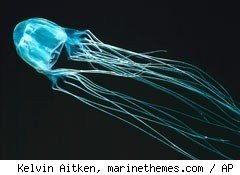جوري
Soldier Through It!
- Messages
- 27,759
- Reaction score
- 6,095
- Gender
- Female
- Religion
- Islam
Girl Rewrites Medical History, Survives Deadliest Jellyfish Sting
Print Emailhttp://www.islamicboard.com/www.add...h Sting - AOL Health&content=&sms_ss=1&lng=enhttp://www.islamicboard.com/www.add...h Sting - AOL Health&content=&sms_ss=1&lng=enhttp://www.islamicboard.com/www.add...h Sting - AOL Health&content=&sms_ss=1&lng=enhttp://www.islamicboard.com/www.add...h Sting - AOL Health&content=&sms_ss=1&lng=enMore
By Deborah Huso Apr 28th 2010 1:10PM
Categories: News
 Many people are amazed that 10-year-old Rachel Shardlow is alive. The Australian girl was swimming off the north coast of Queensland earlier this week when she was stung by an Australian box jellyfish -- believed to be the world's most venomous creature.
Many people are amazed that 10-year-old Rachel Shardlow is alive. The Australian girl was swimming off the north coast of Queensland earlier this week when she was stung by an Australian box jellyfish -- believed to be the world's most venomous creature.
Shardlow's 13-year-old brother pulled her from the water, and she fell unconscious only moments later. Miraculously, she survived, her only apparent injuries being severe scarring on her leg (pictured below), caused by a combination of the jellyfish's harpoon-like tentacles and the highly lethal venom, as well as some short-term memory loss.
Shardlow was lucky. Some say her survival has rewritten medical history, comparing it to the three people worldwide who have survived rabies, which is fatal in almost all cases.
Because the sting of the box jellyfish is so painful and venomous, victims will often go into shock within minutes, and many die of heart failure before they can receive medical assistance. The box jellyfish's venom attacks the heart, nervous system and skin cells. Michael Watters, Ph.D., a marine neurotoxicology expert out of the University of Hawaii and a fellow of the American Academy of Neurology (AAN), says Australian box jellyfish stings have about a 20 percent mortality rate. The toxin the jellyfish release into the bloodstream essentially causes victims to lose muscle control, including respiration.
Stephen Epstein, M.D., an emergency physician at Beth Israel Deaconess Medical Center in Boston and a spokesman for the American College of Emergency Physicians (ACEP), says one reason severe box jellyfish stings prove so deadly is because victims are stung in the water and are not able to get out of the water before they go into shock. "This is one creature you don't want to encounter in the wild," he says. "It can cause very rapid death."
 Australian box jellyfish live primarily in the coastal waters off northern Australia and throughout the Indo-Pacific. They are most numerous during Australia's rainy season from November through April, and they tend to congregate near the mouths of rivers (which is where Shardlow was stung) and creeks. Often beaches are closed to swimmers during the rainy season, precisely because of the box jellyfish threat.
Australian box jellyfish live primarily in the coastal waters off northern Australia and throughout the Indo-Pacific. They are most numerous during Australia's rainy season from November through April, and they tend to congregate near the mouths of rivers (which is where Shardlow was stung) and creeks. Often beaches are closed to swimmers during the rainy season, precisely because of the box jellyfish threat.
Jeffrey Sankoff, M.D., an emergency department physician at Denver Health Medical Center and also an ACEP member, has traveled in Australia a great deal. "This is the time of year when box jellyfish are most active," he says. "There are huge signs everywhere telling you to stay out of the water." Sankoff says that's one reason he's baffled as to what Shardlow was doing in the water in the first place.
The box jellyfish's transparent body is relatively small (measuring only inches in length), but its dozen or so tentacles can grow as long as 10 feet. The creature packs a powerful toxic punch, and there is anti-venom available, but getting access to it promptly is key. Emergency medical technicians in Australia have the anti-toxin in their ambulances, so if emergency assistance arrives right away, chances of survival are good.
 There are no box jellyfish in the waters off the continental United States, but if you're traveling in the Indo-Pacific, be wary, and if you or someone you know should be stung, take action immediately. Emergency physicians recommend the following:
There are no box jellyfish in the waters off the continental United States, but if you're traveling in the Indo-Pacific, be wary, and if you or someone you know should be stung, take action immediately. Emergency physicians recommend the following:
• Get the victim out of the water as quickly as possible
• Seek medical help immediately, as time and access to anti-toxin is everything in surviving an attack
• Flood the stings with vinegar, and be sure to soak the stung areas and the tentacles with vinegar and/or hot water for about 10 minutes before attempting to remove the tentacles
• Remove the tentacles with a tweezer or stick, and use gloves or a towel, as the darts on the ends of the tentacles likely still contain venom
• You can use a pressure dressing, like an ACE bandage, around sting areas on arms and legs (just be careful not to cut off blood flow), as this decreases the spread of the toxin
• If the victim stops breathing or isn't showing a pulse, administer CPR.
Related:
Marine Stings and Scrapes
Unbelievable X-rays
http://www.aolhealth.com/2010/04/28/girl-survives-deadliest-jellyfish-sting/?icid=main|htmlws-main-w|dl1|link3|http%3A%2F%2Fwww.aolhealth.com%2F2010%2F04%2F28%2Fgirl-survives-deadliest-jellyfish-sting%2F
Print Emailhttp://www.islamicboard.com/www.add...h Sting - AOL Health&content=&sms_ss=1&lng=enhttp://www.islamicboard.com/www.add...h Sting - AOL Health&content=&sms_ss=1&lng=enhttp://www.islamicboard.com/www.add...h Sting - AOL Health&content=&sms_ss=1&lng=enhttp://www.islamicboard.com/www.add...h Sting - AOL Health&content=&sms_ss=1&lng=enMore
By Deborah Huso Apr 28th 2010 1:10PM
Categories: News

Shardlow's 13-year-old brother pulled her from the water, and she fell unconscious only moments later. Miraculously, she survived, her only apparent injuries being severe scarring on her leg (pictured below), caused by a combination of the jellyfish's harpoon-like tentacles and the highly lethal venom, as well as some short-term memory loss.
Shardlow was lucky. Some say her survival has rewritten medical history, comparing it to the three people worldwide who have survived rabies, which is fatal in almost all cases.
Because the sting of the box jellyfish is so painful and venomous, victims will often go into shock within minutes, and many die of heart failure before they can receive medical assistance. The box jellyfish's venom attacks the heart, nervous system and skin cells. Michael Watters, Ph.D., a marine neurotoxicology expert out of the University of Hawaii and a fellow of the American Academy of Neurology (AAN), says Australian box jellyfish stings have about a 20 percent mortality rate. The toxin the jellyfish release into the bloodstream essentially causes victims to lose muscle control, including respiration.
Stephen Epstein, M.D., an emergency physician at Beth Israel Deaconess Medical Center in Boston and a spokesman for the American College of Emergency Physicians (ACEP), says one reason severe box jellyfish stings prove so deadly is because victims are stung in the water and are not able to get out of the water before they go into shock. "This is one creature you don't want to encounter in the wild," he says. "It can cause very rapid death."

Jeffrey Sankoff, M.D., an emergency department physician at Denver Health Medical Center and also an ACEP member, has traveled in Australia a great deal. "This is the time of year when box jellyfish are most active," he says. "There are huge signs everywhere telling you to stay out of the water." Sankoff says that's one reason he's baffled as to what Shardlow was doing in the water in the first place.
The box jellyfish's transparent body is relatively small (measuring only inches in length), but its dozen or so tentacles can grow as long as 10 feet. The creature packs a powerful toxic punch, and there is anti-venom available, but getting access to it promptly is key. Emergency medical technicians in Australia have the anti-toxin in their ambulances, so if emergency assistance arrives right away, chances of survival are good.

• Get the victim out of the water as quickly as possible
• Seek medical help immediately, as time and access to anti-toxin is everything in surviving an attack
• Flood the stings with vinegar, and be sure to soak the stung areas and the tentacles with vinegar and/or hot water for about 10 minutes before attempting to remove the tentacles
• Remove the tentacles with a tweezer or stick, and use gloves or a towel, as the darts on the ends of the tentacles likely still contain venom
• You can use a pressure dressing, like an ACE bandage, around sting areas on arms and legs (just be careful not to cut off blood flow), as this decreases the spread of the toxin
• If the victim stops breathing or isn't showing a pulse, administer CPR.
Related:
Marine Stings and Scrapes
Unbelievable X-rays
http://www.aolhealth.com/2010/04/28/girl-survives-deadliest-jellyfish-sting/?icid=main|htmlws-main-w|dl1|link3|http%3A%2F%2Fwww.aolhealth.com%2F2010%2F04%2F28%2Fgirl-survives-deadliest-jellyfish-sting%2F


